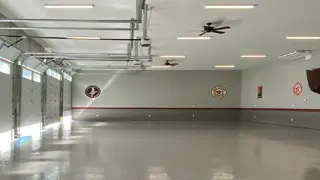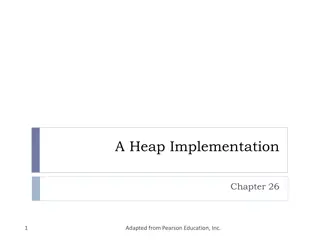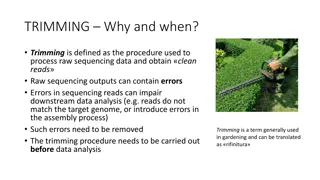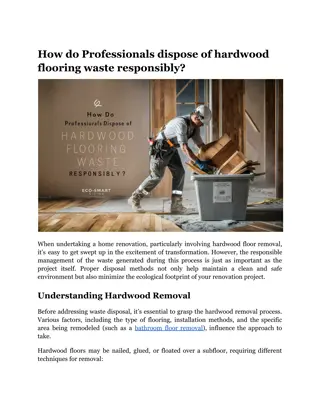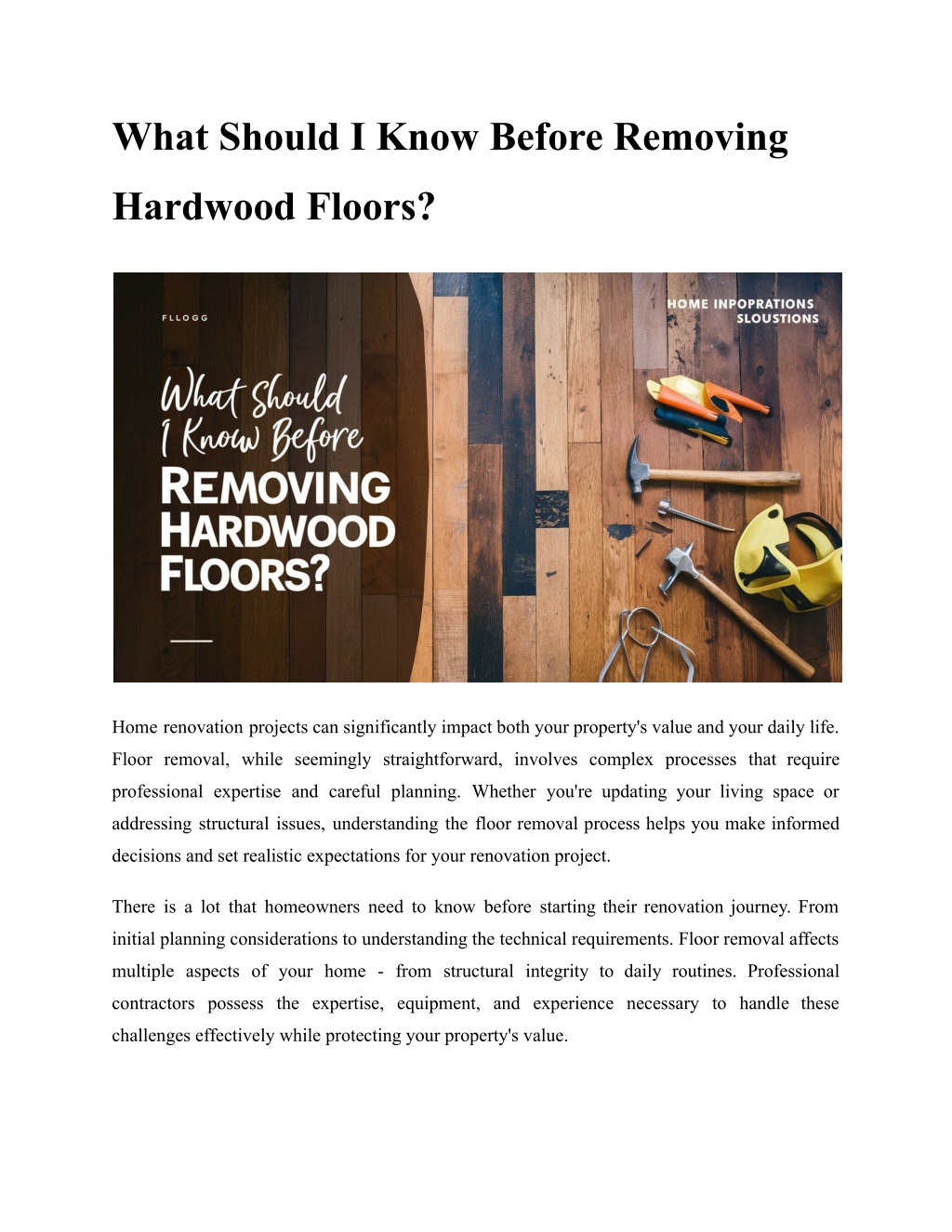
What Should I Know Before Removing Hardwood Floors?
Thinking of removing hardwood floors? Discover key steps, tools, and tips to ensure a safe, hassle-free removal process.n
Download Presentation

Please find below an Image/Link to download the presentation.
The content on the website is provided AS IS for your information and personal use only. It may not be sold, licensed, or shared on other websites without obtaining consent from the author. Download presentation by click this link. If you encounter any issues during the download, it is possible that the publisher has removed the file from their server.
E N D
Presentation Transcript
What Should I Know Before Removing Hardwood Floors? Home renovation projects can significantly impact both your property's value and your daily life. Floor removal, while seemingly straightforward, involves complex processes that require professional expertise and careful planning. Whether you're updating your living space or addressing structural issues, understanding the floor removal process helps you make informed decisions and set realistic expectations for your renovation project. There is a lot that homeowners need to know before starting their renovation journey. From initial planning considerations to understanding the technical requirements. Floor removal affects multiple aspects of your home - from structural integrity to daily routines. Professional contractors possess the expertise, equipment, and experience necessary to handle these challenges effectively while protecting your property's value.
The Basics Of Professional Floor Removal Professional hardwood floor removal requires extensive preparation and specialized knowledge. Many homeowners underestimate the complexity involved in removing existing flooring materials. A professional assessment begins with evaluating your floor's specific characteristics, including: Initial Assessment Requirements Professional contractors start with a thorough evaluation of: Floor-type and condition Subfloor integrity Structural considerations Presence of hazardous materials Moisture levels and potential water damage Underlying support system health This initial assessment determines the appropriate removal techniques and equipment needed for your specific situation. Professional contractors document existing conditions and potential challenges, ensuring transparent communication about the scope of work required. Experienced professionals also evaluate adjacent areas that might be affected by the removal process. This includes checking for: Load-bearing wall proximity Electrical and plumbing considerations HVAC system components Door clearances and transitions Built-in cabinet interactions
Complex Considerations for Different Areas Every room presents unique challenges. When professionals undertake bathroom floor tile removal, they must account for various factors not present in other spaces. Bathroom floors often have complex layouts with toilets, vanities, and shower areas requiring special attention. The presence of water lines and drain connections adds another layer of complexity to the removal process. Professional Equipment and Safety Protocols The complexity of floor removal demands specialized equipment and strict safety measures. When professionals tackle a hardwood floor removal project, they arrive with industrial-grade tools specifically designed for efficient and safe material removal. This equipment includes: Heavy-duty floor-stripping machines Professional-grade dust extraction systems Moisture detection devices Specialized prying and lifting tools Industrial vacuums and containment systems Safety measures become even more crucial in confined spaces. During bathroom floor removal, professionals must manage work in tight quarters while protecting plumbing fixtures and preventing water damage. Their specialized equipment helps navigate around toilets, vanities, and shower areas without compromising the underlying structure. Material-Specific Approaches Different flooring materials require distinct removal techniques. Professional contractors understand that bathroom floor demands different tools and methods compared to hardwood floors. They use specialized equipment to: Break up tile without damaging the subfloor Remove adhesive residue safely
Manage ceramic, porcelain, or natural stone materials Protect surrounding fixtures and walls Contain and dispose of materials properly Environmental Controls and Protection Professional contractors implement comprehensive dust control measures throughout the removal process. This includes: Setting up negative air pressure systems Installing proper ventilation Using HEPA filtration Creating sealed work zones Protecting HVAC systems Special consideration goes into moisture management, particularly during bathroom projects. Professionals carefully monitor humidity levels and existing moisture conditions to prevent potential mold growth or structural damage. Project Planning and Timeline Expectations Professional floor removal projects require careful scheduling and coordination. The timeline varies significantly based on room type and existing conditions. For instance, hardwood floor removal in main living areas might progress faster than specialized spaces due to open layouts and fewer obstacles. Scheduling Considerations Most professional contractors break down their timelines into distinct phases: Preparation Phase (1-2 Days):
Protecting surrounding areas Setting up containment systems Removing furniture and fixtures Installing temporary facilities if needed Active Removal Phase: During this phase, professionals manage different timelines based on the space. While the bathroom floor might require 2-3 days due to fixture complications and moisture considerations, larger open areas might progress more quickly. Factors affecting the timeline include: Square footage Material type Subfloor condition Fixture complexity Accessibility issues Space-Specific Timelines Bathroom renovations often require additional time due to their complexity. When undertaking bathroom floor tile removal, professionals account for: Toilet and fixture removal Waterproofing assessment Plumbing protection Multiple material layers Limited workspace navigation Post-Removal Procedures After the primary removal work, professionals: Assess subfloor condition Document any discovered issues
Clean and prepare surfaces Remove all debris Verify structural integrity Conduct moisture testing Impact Management Professional contractors develop strategies to minimize disruption to your daily routine. They consider: Access to essential facilities Noise control during working hours Dust containment between spaces Clear communication about progress Daily cleanup procedures What About The Project Costs and Value? The investment in professional floor removal varies significantly based on multiple factors. While square footage plays a major role, the complexity of the space and existing conditions often have an equal or greater impact on final costs. Cost-Influencing Factors Several elements affect project pricing: Primary Considerations: Total area dimensions Existing material types Subfloor conditions
Structural complexities Location accessibility When dealing with specialized spaces like bathrooms, costs often reflect additional complexities. The presence of fixtures, multiple material layers, and moisture management requirements can impact the overall investment. For example, bathroom floor removal typically demands more intensive labor and specialized approaches compared to open-space projects. Value Considerations Professional removal services provide several key benefits: Structural Protection: Proper technique application Damage prevention Subfloor preservation Support system protection Foundation safeguarding Quality Preparation: Surface evaluation Moisture barrier assessment Level foundation creation Proper cleanup procedures Future installation preparation Hidden Cost Prevention Professional assessment helps identify potential issues early: Structural weaknesses Water damage signs Pest infestation indicators
Ventilation problems Support system concerns Consider how hardwood floor removal in main living areas might reveal previously hidden issues affecting your home's integrity. Early detection through professional assessment often prevents more costly repairs later. Additional Service Value Professional contractors typically include: Comprehensive insurance coverage Written guarantees Detailed documentation Expert consultation Future recommendations The Takeaway Professional floor removal requires expertise, proper equipment, and careful planning. The success of your project depends heavily on choosing experienced professionals who understand the complexities of different removal scenarios and materials. Looking for expert floor removal services? Tear It Up Floor Removal brings decades of professional experience to every project. Contact them today for a professional consultation and experience the difference of working with industry leaders. Site Article: What Should I Know Before Removing Hardwood Floors?







